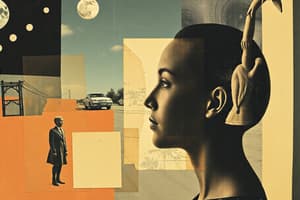Podcast
Questions and Answers
What role does size constancy play in perception?
What role does size constancy play in perception?
- It allows us to perceive objects as the same size regardless of their distance. (correct)
- It facilitates the perception of depth in images.
- It helps us perceive objects as different sizes based on their distance.
- It ensures objects appear larger the closer they are.
Which principle of Gestalt psychology involves filling in gaps to form a whole object?
Which principle of Gestalt psychology involves filling in gaps to form a whole object?
- Continuity
- Closure (correct)
- Similarity
- Proximity
What determines the color we perceive from light?
What determines the color we perceive from light?
- Frequency of the light waves
- Amplitude of the light waves
- Intensity of the light waves
- Wavelength of the light waves (correct)
Which component of the ear is responsible for converting sound waves into neural signals?
Which component of the ear is responsible for converting sound waves into neural signals?
In the concept of monocular depth cues, what is represented by relative size?
In the concept of monocular depth cues, what is represented by relative size?
What is the primary role of sensory receptors in the process of sensation?
What is the primary role of sensory receptors in the process of sensation?
Which type of sensory receptor is primarily involved in detecting pain?
Which type of sensory receptor is primarily involved in detecting pain?
What phenomenon does the Ponzo illusion illustrate regarding depth perception?
What phenomenon does the Ponzo illusion illustrate regarding depth perception?
Which statement accurately defines the difference between sensation and perception?
Which statement accurately defines the difference between sensation and perception?
Which part of the human eye is primarily responsible for focusing light onto the retina?
Which part of the human eye is primarily responsible for focusing light onto the retina?
Which of the following refers to objects being perceived as related based on their spatial proximity?
Which of the following refers to objects being perceived as related based on their spatial proximity?
What aspect of auditory perception is determined by the frequency of sound waves?
What aspect of auditory perception is determined by the frequency of sound waves?
Which characteristic is unique to rods among the photoreceptors in the retina?
Which characteristic is unique to rods among the photoreceptors in the retina?
How does our brain handle color perception under varying lighting conditions?
How does our brain handle color perception under varying lighting conditions?
What process transforms physical stimuli like light into neuronal signals?
What process transforms physical stimuli like light into neuronal signals?
How does binocular depth perception specifically assist in visual recognition?
How does binocular depth perception specifically assist in visual recognition?
Which part of the retina is primarily associated with the highest visual acuity?
Which part of the retina is primarily associated with the highest visual acuity?
Which of the following statements about cones is true?
Which of the following statements about cones is true?
In what way does the iris contribute to the process of vision?
In what way does the iris contribute to the process of vision?
Which wavelength range is considered visible light to the human eye?
Which wavelength range is considered visible light to the human eye?
Study Notes
Sensation vs. Perception
- Sensation is the process of detecting stimuli from the environment, using sensory receptors and the nervous system
- Perception is how the brain organizes and interprets this sensory information, allowing us to understand objects, events, and patterns
- Example: Sensation occurs when light hits the retina, while perception happens when the brain interprets this light as an image or object
Sensory Receptors & Transduction
- Sensory receptors are specialized neurons that detect external stimuli
- Sensory transduction is the process of converting physical stimuli (like light or sound) into chemical energy (neuronal signals)
- This is the first step in sensation
- Example: In vision, light waves are transduced into neural signals that the brain interprets as visual images
The Visual System
- Light is a form of electromagnetic radiation, with wavelengths between 380 nm and 760 nm being visible to the human eye
- Key parts of the eye:
- Cornea: Transparent outer layer where light enters
- Iris: Muscular ring that controls the size of the pupil (the hole where light enters)
- Lens: Focuses light onto the retina
- Retina: Contains the photoreceptors (rods and cones) responsible for detecting light
- Optic nerve: Transmits signals from the retina to the brain
Photoreceptors: Rods vs. Cones
- Cones:
- Responsible for detailed, color vision and work best in daylight
- Concentrated in the fovea, the area of the retina with the highest visual acuity
- Rods:
- More numerous than cones and responsible for vision in low-light conditions
- Located primarily in the peripheral parts of the retina and does not detect color
- Example: In dim light, we rely more on rods, which is why colors are harder to see at night
Depth Perception
- Binocular depth cues:
- Relies on the slightly different views from both eyes (retinal disparity) and the convergence of the eyes when focusing on objects up close
- Monocular depth cues:
- Useful for objects at greater distances and include cues like relative size (closer objects appear larger) and linear perspective (parallel lines appear to converge as they get farther away)
- Example: The Ponzo illusion is a classic example of how linear perspective can trick our depth perception
Gestalt Principles of Perception
- Gestalt psychology studies how we perceive whole objects rather than just a collection of parts
- Key principles:
- Closure: We fill in gaps to create a complete object
- Similarity: Objects that are similar are grouped together
- Proximity: Objects that are near each other are perceived as related
- Good continuation: We perceive smooth, continuous lines rather than disjointed ones
Perceptual Constancies
- Size constancy: We perceive objects as the same size even if their image on the retina becomes smaller as they move away
- Shape constancy: We perceive objects as maintaining the same shape even when viewed from different angles
- Color constancy: Our brain adjusts for changes in lighting so that we perceive objects as maintaining their color
Light as a Stimulus
- Light is part of the electromagnetic spectrum (380-760 nm)
- Wavelength determines color (short = blue/violet, long = red)
The Auditory System
- Sound waves are created by vibrating objects
- Frequency (Hz) determines pitch, amplitude (dB) determines loudness
- Structure of the ear:
- Outer ear (Pinna): Collects sound waves
- Middle ear: Tympanic membrane (eardrum) & ossicles (malleus, incus, stapes)
- Inner ear: Cochlea, where sound is transduced into neural signals by hair cells
Transduction of Sound
- Sound vibrations move the basilar membrane, shearing hair cells, which convert it to neural signals (auditory nerve)
Somatosensory System
- Detects sensations: touch, pressure, vibration, pain, temperature
- Receptors: pressure-sensitive, thermoreceptors, nociceptors (pain)
The Homunculus & Somatosensory Cortex
- Sensory input is mapped in the brain; body parts with more sensory input are represented larger (e.g., hands, lips)
Studying That Suits You
Use AI to generate personalized quizzes and flashcards to suit your learning preferences.
Related Documents
Description
Test your understanding of sensation and perception, including the roles of sensory receptors and transduction. Explore how the visual system processes stimuli and interpret visual information. This quiz covers key concepts and examples to deepen your knowledge.




